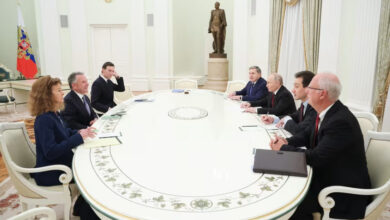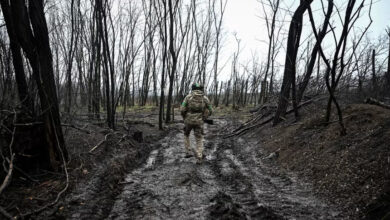
(CNN) – Russia’s war in Ukraine is approaching the one-month mark, and its troops’ advancement on some key cities, including the capital of Kyiv, appears to have slowed.
While there’s a growing picture that Russia’s assault on Ukraine has not gone to plan, the country continues to use its air power to obliterate cities and target civilians to push Ukraine into submission.
So where is this war going? Here are five things to watch out for in coming weeks.
1. Russia could intensify its bombing campaign

Experts are warning that the more Russia takes a hit on the ground, the more likely it is to intensify its aerial bombing campaign and the use of other “standoff” weapons that put Russian soldiers in less danger.
There is little reliable information coming out of either Ukraine or Russia on death tolls, but a report in a Russian tabloid on Monday suggested that the Russian side had lost nearly 10,000 soldiers and that another 16,000 had been injured.
The Komsomolskaya Pravda website removed the numbers later in the day, claiming the numbers only appeared in the first place because it had been hacked. CNN could not verify the numbers, but the death toll is closer to what US intelligence agencies have been reporting.
Such losses, if proven to be true, would explain both the stall in ground movement and the uptick in aerial bombing of key cities and other standoff attacks.
A senior US defense official said Russia has begun firing on the southern city of Mariupol from ships in the Sea of Azov.
“Russia still has capabilities and reserves, and there’s going to be an uptick in intensity as it makes an effort to bring in more troops,” Jeffrey Mankoff, a distinguished research fellow at the US National Defense University’s Institute for National Strategic Studies, told CNN.
A recent UK Defense Ministry update said that Russia was pulling in troops from across the country, and as far away as its Pacific Fleet. It is also pulling fighters from Armenia and private military companies, Syrians and other mercenaries, it said.
The question is how long Russia can continue with high losses of personnel.
“There’s going to be more troops and other equipment and help, of course, but there is a point where it’s going to be hard to sustain this kind of an operational tempo, particularly the figures that we’ve been hearing about both in terms of men and material losses, when it outstrips the ability to resupply,” Mankoff said.
2. While there’s focus on Kyiv, Russia may try to encircle Ukrainian fighters in the east
3. There will be more talk about talks
Russian officals, left, and Ukrainian officials, right, during talks on February 27 in the Gomel region of Belarus.
One scenario is that the Ukraine war could become a protracted conflict. It’s likely that Russia has lost a significant number of soldiers, weapons and equipment in the war, and while it has engaged in long-running conflicts in the past, it won’t want to leave this one with its military totally destroyed.
“The negotiations are the one area where things are looking a little promising because both Russia and Ukraine have said in the last week that they’re moving towards an actual substantive discussion, instead of Russia just laying down an ultimatum,” Keir Giles, a Russian expert at the UK-based think tank Chatham House, told CNN.
Russian officials have said that their demands include Ukraine dropping its pitch to join NATO and to demilitarize and adopt a “neutral” status, like Austria and Sweden have. But the conditions for what that means for Ukraine would have to be negotiated.
President Vladimir Putin’s chief spokesman, Dmitry Peskov, told CNN in an interview Tuesday that Russia also wanted Ukraine to accept that Crimea — which Russia annexed in 2014 — is officially part of Russia and that the breakaway statelets of Luhansk and Donetsk “are already independent states.”
Numerous experts have speculated that Russia will look to carve off parts of eastern Ukraine.
“It’s going to be painful to deliberate, unless it becomes possible for Western aid, both military and humanitarian, to be absorbed in Ukraine at sufficient rates that they can genuinely turn the tide against the Russian advancement,” Giles said.
“If it’s a question of who can pour in the greater resources and take the greater pain in order to prevail, Russia has a track record for inflicting substantial economic damage on itself and suffering on its own population, in order to prosecute wars,” said Giles, referring to sanctions that are starting to bite the Russian economy.
But US officials are not so optimistic talks will go well. US Secretary of State Antony Blinken said at a press conference last week that a diplomatic solution to the war was unlikely, saying that Russia’s actions “are in total contrast to any serious diplomatic effort to end the war.”
He also suggested that Russia would escalate the war by using chemical weapons.
4. There could be wholesale ‘deportations’ of Ukrainians into Russia. That’s worrying
5. Millions more Ukrainians could flee, leaving a nation in pieces
Ukrainian refugees arriving at Przemysl train station in Poland on March 20, 2022.
The fate of the war is one thing, but the fate of Ukraine is another. Just as Russian air power left some of Syria’s cities and towns in rubble, parts of Ukraine are beginning to look the same.
Already, more than 3.5 million Ukrainians have left the country. Most are women and children, meaning families are also being torn apart. The war has triggered the biggest movement of refugees Europe has seen since World War II.
Those numbers are increasing at a rate of around 100,000 people a day.
If you include the number of people internally displaced, 10 million Ukrainians have now left their homes. That’s nearly a quarter of the country’s population.
And what past wars show is that refugees often never return to their home countries. So often there is little to return to. Sometimes the threat of yet another war is enough to keep refugees away.
It’s something that negotiators will need to think about in any talks on the horizon. Even if a diplomatic solution can be found to end this war, a question that will remain is whether it’s enough to prevent the next one, Cranny-Evans said.
“If we look, historically, at authoritarian regimes that perform poorly in a military setting, the don’t tend to change their behavior in a positive direction afterwards. So the question might be that if the Ukrainians say, ‘OK, we will be neutral, just get out,’ the Russians might say ‘No, you have to give us Donetsk and Luhansk. That might be bearable for Ukraine, perhaps, in order to stop the war,” he said.
“But what if, for instance, 10 years down the line, Ukraine has advanced on a significant military modernization? Or the next Russian president wants to prove his worth, and they conduct another war? There are a lot of scenarios to think through in terms of what ending this war could lead to.”








